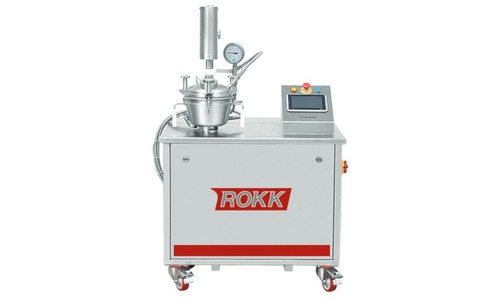ROKK CCM Multi-functional universal industrial mixers, capable of cooking, cooling, and mixing under Vacuum condition, all in a single unit, are becoming essential tools across various industries. This article explores their significance, features, and applications, detailing their benefits and providing tips on choosing the right mixer for your needs.
Understanding ROKK CMM Universal Multi-Functional Industrial Mixers
Multi-functional cook, cool, and mix mixers are engineered to integrate cooking, cooling, and mixing processes under vacuum, all into one machine. They are crucial for streamlining operations, reducing the need for multiple pieces of equipment, and enhancing overall production efficiency. They are widely used in the food and beverage, pharmaceuticals, and chemical processing sectors, where precise temperature control and consistent mixing are paramount.
Key Features and Components
The primary advantage of ROKK CCM multi-functional mixers is their ability to combine different processing functions. Here’s a closer look at each of these functions:
- Cooking: The cooking function heats ingredients to specific temperatures, often using direct steam injection or indirect heat/cool via the external recirculation jacket. This step is vital for cooking, pasteurization, or sterilization processes to achieve the desired product texture and flavour.
- Cooling: After cooking, the cooling function rapidly lowers the product’s temperature. Cooling is done by recirculating chilled water around the mixers external double jacket.
- Mixing: The mixing function ensures the even distribution of ingredients throughout the product. This is essential for achieving consistency in texture, flavor, and appearance.
- Vacuum: Cooking processing is done under vacuum condition, which is achieved using an in-built and fully integrated vacuum pump. Under vacuum condition, you are able to achieve lower boiling point. Also Vacuum helps with deaerating the product during the mixing operation or removing any foul odours. Vacuum can be used to such dry and wet ingredient directly into the mixer, during mixing or cooking operation.
Different types of ROKK CCM Universal multi-functional mixers cater to various industry needs. Some models are designed for high-shear mixing, which is ideal for creating emulsions and dispersions, while others focus on gentle mixing for delicate products.
Applications Across Industries
The versatility of multi-functional mixers makes them suitable for numerous industries. Here’s how they are used in different sectors:
- Food and Beverage: In food processing, these mixers are invaluable for making sauces, ketchups, mayonnaise, relishes, chocolate process, caramel preparation, soups, processed cheese, blended butter and ready-to-eat meals. They ensure ingredients are cooked to the right temperature, quickly cooled to preserve freshness, and uniformly mixed for consistent quality.
- Pharmaceuticals: Precision and sterility are crucial in pharmaceutical production. Multi-functional mixers blend active pharmaceutical ingredients with excipients, ensuring uniform dosage forms like tablets, creams, and syrups. The ability to cook and cool during processing helps maintain the stability of sensitive compounds.
- Chemical Processing: In the chemical industry, these mixers handle reactions requiring precise temperature control and thorough mixing. They are used to produce polymers, resins, and other chemical compounds, ensuring homogeneous mixing and consistent product quality.
Benefits of Using Multi-Functional Mixers
Adopting multi-functional industrial mixers offers several advantages:
- Efficiency and Time-Saving: By combining cooking, cooling, and mixing in one unit, these mixers reduce the need for multiple machines, streamlining production lines and saving time. This integration minimizes transfer losses and contamination risks of moving products between separate machines.
- Consistency in Product Quality: These mixers precisely control processing conditions, ensuring that each batch meets stringent quality standards. Consistent temperature and mixing result in uniform products, enhancing reliability and customer satisfaction.
Environmental and Cost Benefits
Implementing multi-functional industrial mixers can lead to significant environmental and cost benefits. Here’s how:
- Energy Efficiency: These mixers often incorporate advanced technologies that optimize energy use during cooking, cooling, and mixing.
- Reduced Waste: The integrated design of multi-functional mixers minimizes product loss during transfers between different processing stages. This reduction in waste not only lowers costs but also lessens the environmental impact of production.
- Lower Operational Costs: Fewer machines needed to perform multiple functions can save companies on equipment costs, maintenance, and space. This consolidation leads to lower overall operational expenses, making the production process more cost-effective.
- Water Conservation: Some multi-functional mixers are designed to use water more efficiently, particularly in the cooling phase. By recycling and reducing water usage, these mixers support water conservation efforts and help companies adhere to environmental regulations.
Choosing the Right Mixer
Selecting the right multi-functional mixer involves considering several factors:
- Production Volume: Assess your production capacity needs to choose a mixer that can efficiently handle your desired batch sizes.
- Product Characteristics: Consider the properties of the materials you process. High-viscosity products may require mixers with strong agitation capabilities, while delicate ingredients might need gentle mixing.
- Temperature Control: Evaluate the mixer’s temperature range and control precision, especially if your processes involve sensitive temperature variations.
- Maintenance and Cleaning: To ensure uninterrupted production and hygiene, opt for mixers with easy-to-clean designs and minimal maintenance requirements.
Final Thoughts
ROKK CCM Universal Multi-functional industrial mixers are transformative tools that enhance efficiency, consistency, and versatility across various industries. By understanding their features, applications, and benefits, you can optimise your production processes and achieve superior product quality.


